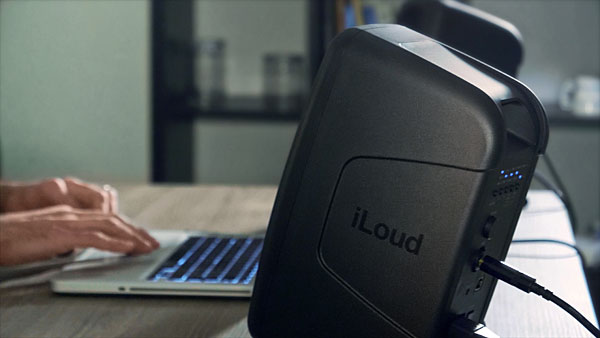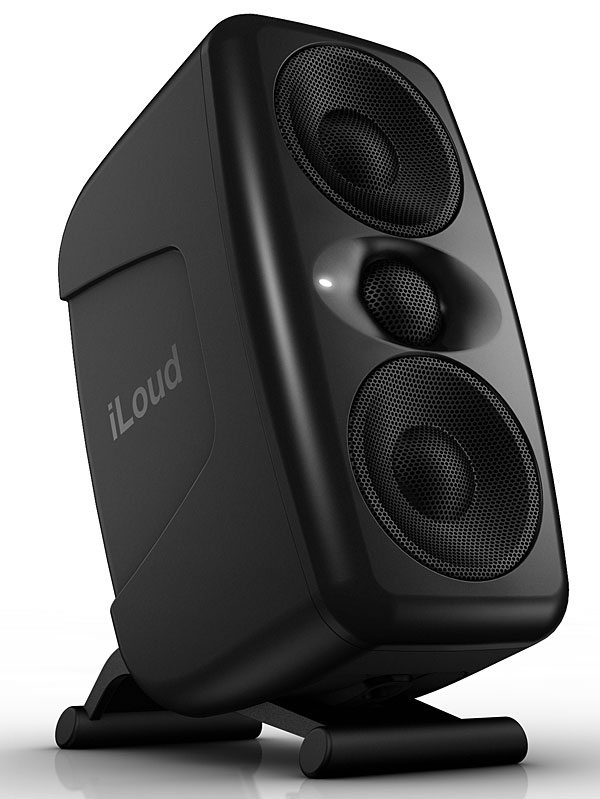IK Multimedia iLoud MTM Powered Monitor Review Page 2
I ultimately ended up with the MTMs carefully aimed as noted, with both HF and LF controls set to Flat, and the Desk EQ preset enabled. This preset curve definitely provided the most uncolored sound on my desktop, while in subsequent checks the Flat setting did the same for far-field listening. I almost always set bass extension at 40Hz to enjoy the MTMs full-range, and never ran out of suitable level. That said, I generally don't listen as loudly as some: perhaps 3 to 6dB short of lifelike is where I usually settle.

"Dance of the Knights," the 13th scene of Prokofiev's Romeo and Juliet ballet opens with strikingly rich orchestral bass, vamping between the lowest E and G of the basses and trombones and bassoons, with tuba and contrabassoon reinforcing the lowest octave right down to 41Hz. On a warmly balanced recording by the Detroit Symphony and Dutoit streamed via Qobuz, the E sounded just as powerful as the G, meaning the MTMs really were effectively flat to 40Hz on my desk. Prokofiev's textures were easily discerned, with the buzz of the contrabassoon distinct from the gooey bass of the tubas and trombones. (Does this scene's second theme remind you of John Williams' motif for the evil Emperor? As Stravinsky is said to have said, "Mediocre composers borrow, great ones steal.")
On my desktop, the IKs sounded clean, dynamic, and free of colorations or distortions, even at the lower frequencies where you'd expect 3.5-inch woofers to consider filing complaints. A good example was the opening few bars of the first of Ravel's Valses Nobles et Sentimentales, whose double-fisted, close-clustered chords make substantial demands of any speakers. At any real-world listening level this remained pristine, clearly limned and colorful, even at fourth-row loudness. Pushed to near-absurd levels, however, as loud or perhaps louder than what the pianist might hear if he or she were a genuine schlager (pounder), the sound became a little murky in the lower-mids. I guessed that this was at least in part the port output of the little enclosures getting a bit noisy/ raggedy, but this was loud, indeed: too loud for recreational desktop listening.

I've been revisiting the delightful and surprisingly well-produced early Earth, Wind & Fire recordings. (This is pre-MIDI, pre-computers, when every note overdubbed or not was actually performed by a human, in real time.) A little-heard track such as "Jupiter" invited repeated listening to marvel at the tight, insistent boogie and wonderful horn-section ensemble. And with each repeat I found myself indulging in a few dB or so more level. Why not? Even nearing club-like levels I had no complaints with regard to dynamics definition— remember, I was listening at less than one meter. At more extreme settings the powerful bass ostinati became slightly tubbier and fluttery, but I've heard far worse from designs several times the MTMs' cubic volume.
IK's ARC room correction runs via a supplied measurement mic that connects to a rear-panel mini-jack. You must run the routine independently on each speaker, with the process taking less than a minute for each, and the result is applied via the MTM's rear-panel Cal/Preset switch. The results were, to my ear, a bit puzzling. Compared with the Desk EQ preset I had been using, bass and highs both seemed a bit stymied, yielding a rather midrange- forward presentation that was not, in my opinion, an improvement. (My desk layout is rather odd, though, with a curved desk-edge and partial-corner location, so don't take this as definitive.) A subsequent ARC run in my far-field setup produced the results I've come to expect from count- less trials with other competent correction systems, including a subtle tightening of bass and an increase of midrange "focus" delivered by mitigation of the room's principal modes.

I also tried the MTMs in my "big" system, comparing them with my long-term 5-1/4-inch three-way powered monitors, which themselves have indexed closely to a succession of highly accurate speakers. The comparison was instructive: the MTMs (set to Flat all around) sounded very slightly "leaner" in upper-bass/lower-mids terms, and rather more sharply etched in delineating upper-mids and treble textures. Otherwise, the two were a near-perfect match for timbral balance, dynamics — most everything, really, including bass extension and output. The exception was spatial character, where the MTMs sounded just barely "drier" in their presentation of recorded space and reverberation.
As to the question of peak level, the MTMs didn't equal the much bigger monitors from my nearly four-meter listening distance: two doublings of my desktop- listening distance for a probable four-times power demand. Here they could not really produce realistic levels of large-dynamic acoustic music—orchestral or big-band jazz, for example—but they came amazingly close, and should prove perfectly capable in a small room.
Back on the desktop, I found that as long as you stay within its dynamic-range limits, the MTMs take to equalization like a merganser to a mere. A session spent fooling around on my iMac with the Roon music management software's digital-EQ features suggested I could make the IKs sound pretty much however I wanted, but the design's intrinsic response is so accurate it was very hard to improve upon, while the onboard EQ trims will provide enough adaptability for most listeners.
Anything missing? Some scheme to easily integrate a subwoofer would be nice (though Y-cables will work just fine). Ergonomically, my one complaint is that the MTMs' should have an auto-on/off option, since in a real-world setup having to scrabble for the rear-panel power-switch on each speaker is awkward.
Conclusion
Whatever you call it—desktop monitor, multimedia speaker, or super-compact—IK's MTM is a sterling design. For desktop listening, I don't know that you can do any better at this size and price—or even somewhat higher in either metric. Yes, $700 is not cheap for a desktop system, but remember you'll need no amplifier. You can plug the audio output of a computer straight into your MTMs and get impressive sound or splurge another $100 or so on a USB DAC and get remarkably close to the top of the pops. For anyone seeking a powered solution for the desktop, or for an intimate, small-room system, they earn my highest recommendation.




























































